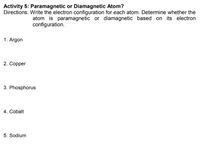
Chemistry
10th Edition
ISBN: 9781305957404
Author: Steven S. Zumdahl, Susan A. Zumdahl, Donald J. DeCoste
Publisher: Cengage Learning
expand_more
expand_more
format_list_bulleted
Concept explainers
Question
Directions: Write the electron configuration for each atom. Determine whether the
atom is paramagnetic or diamagnetic based on its electron
configuration.
1. Argon
2. Copper
3. Phosphorus
4. Cobalt
5. Sodium
show your solutions

Transcribed Image Text:Activity 5: Paramagnetic or Diamagnetic Atom?
Directions: Write the electron configuration for each atom. Determine whether the
atom is paramagnetic or diamagnetic based on its electron
configuration.
1. Argon
2. Copper
3. Phosphorus
4. Cobalt
5. Sodium
Expert Solution
This question has been solved!
Explore an expertly crafted, step-by-step solution for a thorough understanding of key concepts.
This is a popular solution
Trending nowThis is a popular solution!
Step by stepSolved in 4 steps with 3 images

Knowledge Booster
Learn more about
Need a deep-dive on the concept behind this application? Look no further. Learn more about this topic, chemistry and related others by exploring similar questions and additional content below.Similar questions
- ??arrow_forwardConsider the element Work (Wr) with an atomic number of 33 and an atomic mass of 81.03 g/mol. The following information was collected for this element Molecule/ Ion Names Wr-2 Workide WrO3-2 Workate WrO2-2 Workite WrO-3 hydroworkite Draw the Lewis structure of the molecule Workous acid and determine its electron geometry and molecular geometry. What is the mass % of work in Calcium hydroworkite.arrow_forwardI will thumbs up thanksarrow_forward
- Which one of the following describes the bonding between hydrogen and sulfur atoms in H2S? a. The valence S orbital has n=2, and the valence H orbital has n=1. b. The valence S orbital has n=4, and the valence H orbital has n=1. c. The valence S orbital has n=3, and the valence H orbital has n=1. d. The valence S orbital has n=3, and the valence H orbital has n=2.arrow_forward5. Draw a valence bond orbital (VBT) representation of NH3, ammonia. Use singly barbed arrows to represent valence electrons.arrow_forwardDetermine the valence electron configuration for O2+.arrow_forward
- Why does the number of valence electrons matter? The number of electrons in the valence shell determines how an element will bond. If two elements share electrons to fill up their valance shells, they are called covalent bonds. If one element “steals” an electron from another element, those elements no longer have equal numbers of protons and electrons and this they are no longer equal, the element with have a charge. We call elements with charge ions. They are now attracted to each other because they have opposite charges; this is called an ionic bond. We can give an educated guess as to whether an element is likely to bond covalently (share) or ionically (steal) based on where they are on the table. Let’s think about what the columns tell us about the number of valence electrons. If you are an element that is in Group II, you have 2 valence electrons. You would need 6 to complete your shell. How likely is it that another element will share 6 electrons? I think it’s more likely that…arrow_forwardChoose the paramagnetic species from below. Ti4+ Te Xe O All of the above are paramagnetic. None of the above is paramagnetic.arrow_forward1. Draw Lewis Structures (including resonance structures if applicable) for the following molecules/ions: A. NO3– B. NO2– C. NO2+ D. O3 2. Which of the following items in Number 1 are isoelectronic?arrow_forward
arrow_back_ios
arrow_forward_ios
Recommended textbooks for you
 ChemistryChemistryISBN:9781305957404Author:Steven S. Zumdahl, Susan A. Zumdahl, Donald J. DeCostePublisher:Cengage Learning
ChemistryChemistryISBN:9781305957404Author:Steven S. Zumdahl, Susan A. Zumdahl, Donald J. DeCostePublisher:Cengage Learning ChemistryChemistryISBN:9781259911156Author:Raymond Chang Dr., Jason Overby ProfessorPublisher:McGraw-Hill Education
ChemistryChemistryISBN:9781259911156Author:Raymond Chang Dr., Jason Overby ProfessorPublisher:McGraw-Hill Education Principles of Instrumental AnalysisChemistryISBN:9781305577213Author:Douglas A. Skoog, F. James Holler, Stanley R. CrouchPublisher:Cengage Learning
Principles of Instrumental AnalysisChemistryISBN:9781305577213Author:Douglas A. Skoog, F. James Holler, Stanley R. CrouchPublisher:Cengage Learning Organic ChemistryChemistryISBN:9780078021558Author:Janice Gorzynski Smith Dr.Publisher:McGraw-Hill Education
Organic ChemistryChemistryISBN:9780078021558Author:Janice Gorzynski Smith Dr.Publisher:McGraw-Hill Education Chemistry: Principles and ReactionsChemistryISBN:9781305079373Author:William L. Masterton, Cecile N. HurleyPublisher:Cengage Learning
Chemistry: Principles and ReactionsChemistryISBN:9781305079373Author:William L. Masterton, Cecile N. HurleyPublisher:Cengage Learning Elementary Principles of Chemical Processes, Bind...ChemistryISBN:9781118431221Author:Richard M. Felder, Ronald W. Rousseau, Lisa G. BullardPublisher:WILEY
Elementary Principles of Chemical Processes, Bind...ChemistryISBN:9781118431221Author:Richard M. Felder, Ronald W. Rousseau, Lisa G. BullardPublisher:WILEY

Chemistry
Chemistry
ISBN:9781305957404
Author:Steven S. Zumdahl, Susan A. Zumdahl, Donald J. DeCoste
Publisher:Cengage Learning

Chemistry
Chemistry
ISBN:9781259911156
Author:Raymond Chang Dr., Jason Overby Professor
Publisher:McGraw-Hill Education

Principles of Instrumental Analysis
Chemistry
ISBN:9781305577213
Author:Douglas A. Skoog, F. James Holler, Stanley R. Crouch
Publisher:Cengage Learning

Organic Chemistry
Chemistry
ISBN:9780078021558
Author:Janice Gorzynski Smith Dr.
Publisher:McGraw-Hill Education

Chemistry: Principles and Reactions
Chemistry
ISBN:9781305079373
Author:William L. Masterton, Cecile N. Hurley
Publisher:Cengage Learning

Elementary Principles of Chemical Processes, Bind...
Chemistry
ISBN:9781118431221
Author:Richard M. Felder, Ronald W. Rousseau, Lisa G. Bullard
Publisher:WILEY